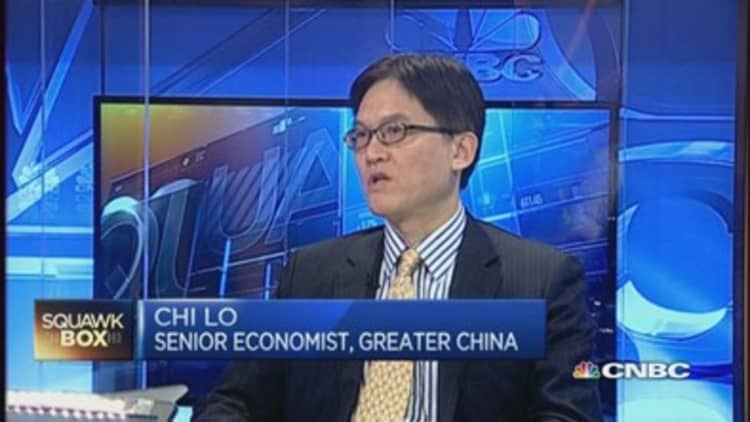
China's consumer inflation increased at its slowest pace in more than five years in January, data showed on Tuesday, adding to concerns over weakening domestic demand and justifying the need for more stimulus action from policymakers.
The consumer price index climbed 0.8 percent from a year ago, below a Reuters consensus for a 1 percent gain and easing from a 1.5 percent rise in December. This marked the weakest reading since November 2009, during the last global financial crisis, when consumer prices rose an annual 0.6 percent.
Wholesale prices, meanwhile, declined for a 35th month. The producer price index fell an annual 4.3 percent, worse than the 3.8 percent decline expected and down from the 3.3 percent drop in December.
China's Shanghai Composite dropped 0.2 percent, while Hong Kong's Hang Seng index opened down 0.3 percent.
China's economy faces the growing risk of deflation, amid a slowing property market, a shrinking factory sector and a collapse in oil prices.
The figures are the latest sign of an economy losing steam. Over the weekend, fresh data showed exports and imports slumping by a wide margin in January, while the official Purchasing Managers' Index released last week pointed to a contraction in manufacturing activity in the month.
"The inflation number is bad news for the economy because it underscores our reading of the deflationary drag on the economy, which has been going on for at least 2 decades," said Chi Lo, senior economist of Greater China at BNP Paribas Investment Partners.
"On the investment perspective, it may not be so bad because the deflationary drag has put pressure on the PBoC and Beijing to keep an easing bias which are good for asset prices going forward," he added.
Last week, China's central bank cut the reserve requirements of major banks (RRR) – or the amount of cash banks must hold back from lending – by 50 basis points, a move that could ultimately inject up to 3 trillion yuan ($480 billion) in the world's second largest economy.
The action followed a surprise interest rate cut by the People's Bank of China in November, which many analysts see as the start of a policy easing cycle. Indeed, most see further easing in the coming weeks and months as policymakers attempt to stem a further economic. slowdown
China's economy grew 7.4 percent in 2014, the slowest pace in 24 years and most market watchers project growth to slow to around 7 percent this year.
"After the Lunar New Year, there will be a bigger chance of a interest rate cut because the inflation number is so low and that will trigger a lot of deflation fears. If deflation occurs in China, that will stall the economy further and that will be harder to rescue the economy," said Jackson Wong, associate director at United Simsen Securities.
Analysts at Citi are maintaining their call for two more rate cuts in the first half.
"We think the RRR cut early this month would help replenish liquidity leaked through capital outflows, and rate cuts are needed to effectively lower the cost of capital. We forecast one cut in Q1 and another in Q2 (25bps each), with the first cut likely this month," they said in a note.
— Reuters contributed to this story.

